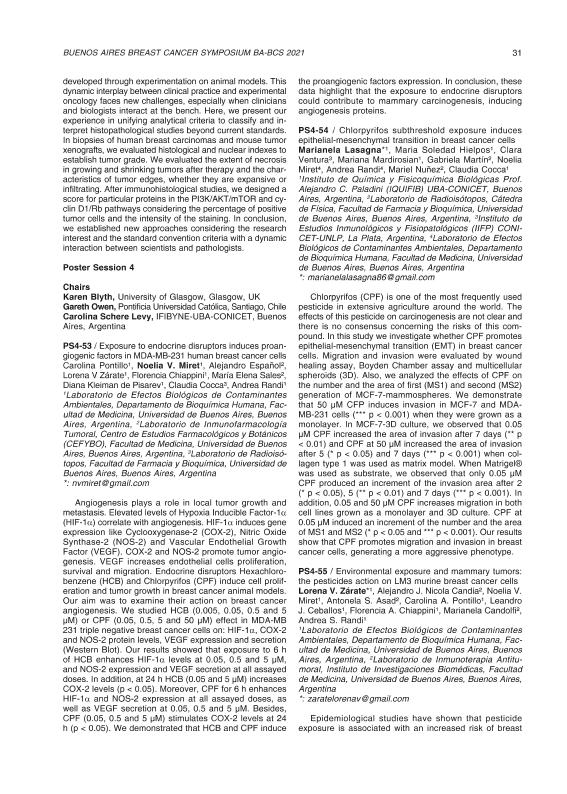Evento
Chlorpyrifos subthreshold exposure induces epithelial-mesenchymal transition in breast cancer cells
Lasagna, Marianela ; Hielpos, María Soledad
; Hielpos, María Soledad ; Ventura, Clara
; Ventura, Clara ; Mardirosian, Mariana Noelia
; Mardirosian, Mariana Noelia ; Martin, Gabriela Adriana
; Martin, Gabriela Adriana ; Miret, Noelia Victoria
; Miret, Noelia Victoria ; Randi, Andrea Silvana
; Randi, Andrea Silvana ; Núñez, Mariel; Cocca, Claudia Marcela
; Núñez, Mariel; Cocca, Claudia Marcela
 ; Hielpos, María Soledad
; Hielpos, María Soledad ; Ventura, Clara
; Ventura, Clara ; Mardirosian, Mariana Noelia
; Mardirosian, Mariana Noelia ; Martin, Gabriela Adriana
; Martin, Gabriela Adriana ; Miret, Noelia Victoria
; Miret, Noelia Victoria ; Randi, Andrea Silvana
; Randi, Andrea Silvana ; Núñez, Mariel; Cocca, Claudia Marcela
; Núñez, Mariel; Cocca, Claudia Marcela
Tipo del evento:
Simposio
Nombre del evento:
Buenos Aires Breast Cancer Symposium
Fecha del evento:
05/2021
Institución Organizadora:
Centro de Educación Médica e Investigaciones Clínicas “Norberto Quirno”;
Instituto de Biología y Medicina Experimental;
Instituto de Fisiología, Biología Molecular y Neurociencias;
Instituto de Investigaciones en Medicina Traslacional;
Instituto de Nanosistemas;
Universidad Austral;
Universidad de Buenos Aires;
Universidad Nacional de San Martín;
Título de la revista:
Medicina
Editorial:
Fundación Revista de Medicina
Idioma:
Inglés
Clasificación temática:
Resumen
Chlorpyrifos (CPF) is one of the most frequently used pesticide in extensive agriculture around the world. The effects of this pesticide on carcinogenesis are not clear and there is no consensus concerning the risks of this compound. In this study we investigate whether CPF promotesepithelial-mesenchymal transition (EMT) in breast cancer cells. Migration and invasion were evaluated by wound healing assay, Boyden Chamber assay and multicellular spheroids (3D). Also, we analyzed the effects of CPF on the number and the area of first (MS1) and second (MS2)generation of MCF-7-mammospheres. We demonstrate that 50 μM CFP induces invasion in MCF-7 and MDAMB-231 cells (*** p < 0.001) when they were grown as a monolayer. In MCF-7-3D culture, we observed that 0.05 µM CPF increased the area of invasion after 7 days (** p < 0.01) and CPF at 50 µM increased the area of invasion after 5 (* p < 0.05) and 7 days (*** p < 0.001) when collagen type 1 was used as matrix model. When Matrigel® was used as substrate, we observed that only 0.05 µM CPF produced an increment of the invasion area after 2 (* p < 0.05), 5 (** p < 0.01) and 7 days (*** p < 0.001). In addition, 0.05 and 50 μM CPF increases migration in both cell lines grown as a monolayer and 3D culture. CPF at 0.05 µM induced an increment of the number and the area of MS1 and MS2 (* p < 0.05 and *** p < 0.001). Our results show that CPF promotes migration and invasion in breast cancer cells, generating a more aggressive phenotype.
Archivos asociados
Licencia
Identificadores
Colecciones
Eventos(IIFP)
Eventos de INST. DE ESTUDIOS INMUNOLOGICOS Y FISIOPATOLOGICOS
Eventos de INST. DE ESTUDIOS INMUNOLOGICOS Y FISIOPATOLOGICOS
Eventos(IQUIFIB)
Eventos de INST.DE QUIMICA Y FISICO-QUIMICA BIOLOGICAS "PROF. ALEJANDRO C. PALADINI"
Eventos de INST.DE QUIMICA Y FISICO-QUIMICA BIOLOGICAS "PROF. ALEJANDRO C. PALADINI"
Citación
Chlorpyrifos subthreshold exposure induces epithelial-mesenchymal transition in breast cancer cells; Buenos Aires Breast Cancer Symposium; Ciudad Autonoma de Buenos Aires; Argentina; 2021; 31-31
Compartir



